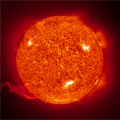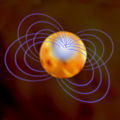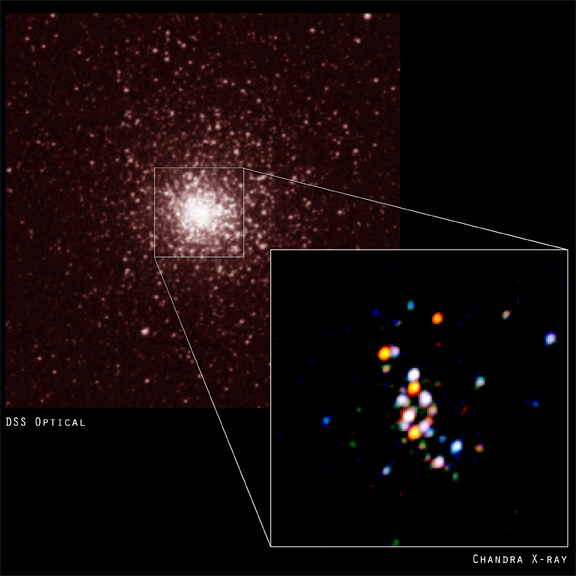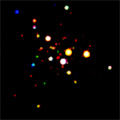An overview of the Chandra mission and goals, Chandra's namesake, top 10 facts.
Classroom activities, printable materials, interactive games & more.
Overview of X-ray Astronomy and X-ray sources: black holes to galaxy clusters.
All Chandra images released to the public listed by date & by category
Current Chandra press releases, status reports, interviews & biographies.
A collection of multimedia, illustrations & animations, a glossary, FAQ & more.
A collection of illustrations, animations and video.
Chandra discoveries in an audio/video format.
Close Encounters of the Stellar Kind
July 31, 2003 ::

Ultraviolet image of the Sun
(Credit: SOHO-EIT) |
If our Sun collided with another star, it would probably be really bad for life on Earth. We're safe from such a fate because the nearest star to the Sun is Proxima Centauri, about 4.2 light years (or 25 million million miles) away. Although most stars are very far apart from each other, there are places in the
Milky Way where stars are so close together that they actually do sometimes fly into each other, or at least have near misses.
These places are called "globular clusters," circular clumps of over a million stars squashed into a small area that are located at the edges of galaxies. The stars in globular clusters are continually buzzing around in a confined space, and they do, in fact, often crash into each other.

Illustration of a Neutron Star |
Sometimes, two stars like the Sun directly collide and join to form a bigger, brighter star. While that is spectacular to imagine, scientists have learned that even more complicated types of collisions take place in globular clusters. For example, a double star containing two stars like our Sun orbiting around each other can meet up with a
neutron star. (A neutron star is a small, but extraordinarily dense object that is the remnants of a star has run out of fuel and collapsed.) After a complicated dance, the lightest object, one of the Sun-like stars, is shot out and replaced by the neutron star.

NGC 6266 X-ray/Optical Composite |
During this exchange of stellar dance partners, the stars never even touch directly, but that doesn't mean they don't have an effect on each other. Scientists have figured out that if the two objects in this new double star system are very close together, the strong gravity of the heavier neutron star will rip gas away from the surface of the Sun-like star. This gas falls onto a hot disk surrounding the neutron star and eventually to its surface. This transfer causes all sorts of startling behavior such as spectacular explosions and bubbling, cauldron-like changes in the star's brightness.

47 Tucanae |
So, if scientists want to study close stellar encounters in globular clusters, they need the best way to detect these double star (a.k.a. "binary") systems. Because the surfaces of the neutron stars and the disks around them get very, very hot, they put out most of their energy in X-rays. Therefore, astronomers like to use an X-ray telescope, like the
Chandra X-ray Observatory, for this research.
Recently, two groups of astronomers used Chandra to see if their idea of how these binary systems were made in globular clusters was right. To test their theory, the scientists counted the number of binary systems in a dozen globular clusters by finding the stars that were bright in X-rays. Then they predicted how many star crashes should happen in each cluster.
Was their idea correct? Yes, the measurements and the predictions agreed beautifully, and their work proved that the
binary systems in globular clusters formed in collisions. This shows that globular clusters are a great laboratory for studying what happens when stars collide, and, as far as we know, no one gets hurt.








